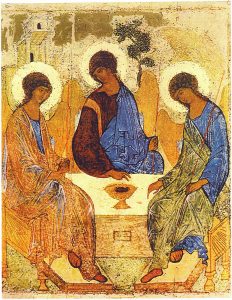HOMILY EASTER OCTAVE – THURSDAY
Participating in the Divine Dance
(Acts 4:1-12; Ps 118; Jn 21:1-14)
************************************************
Richard Rohr’s book The Divine Dance, was inspired by Andrei Rüblev’s painting entitled The Trinity or The Hospitality of Abraham. In that painting, the three angels who visited Abraham in the Old Testament are pictured as Father, Son and Holy Spirit seated around an altar in a gentle, loving, delicate relationship with one another.
 As Rohr puts it, “At the heart of the Christian revelation, God is not seen as a distant, static monarch, but a divine circle dance, or in Greek, perichoresis (the origin of our word choreography). God is the holy one presented in the dynamic and loving action of the Three. The invitation to share at the table by Rublev’s art is a biblical hint of what we would eventually call salvation.
As Rohr puts it, “At the heart of the Christian revelation, God is not seen as a distant, static monarch, but a divine circle dance, or in Greek, perichoresis (the origin of our word choreography). God is the holy one presented in the dynamic and loving action of the Three. The invitation to share at the table by Rublev’s art is a biblical hint of what we would eventually call salvation.
A key to the painting is the space in front of the altar where a mirror originally had been placed, inviting the viewer to see him or her self as a fourth person of this Trinitarian dance, with all of creation. We are invited to be participants with our Trinitarian God in a divine dance of redemption, salvation and fullness of life.
Today’s readings fit within this context of books, movie and painting. St. Peter is the first to step into the dance. After the Pentecost event he is filled with the Spirit and witnesses to the resurrection of Jesus. Is so doing, he reveals God as Trinity (Jesus is “the crucified one;” God “raised him from the dead,” and Peter is “filled with the Holy Spirit”). Peter then proclaims for all the world to hear that there is salvation in no one else. Peter is already a participant in the perichoresis.
St. Peter then proclaims what the psalm echoes – that Jesus is the rejected stone that has become the cornerstone. There has been a shift within the Trinity – Jesus is now the cornerstone of a new creation, the new world order, the very reign of God here on earth that Jesus came to inaugurate – in short, the divine dance.
Turning to the gospel, St. John is the theologian of signs, symbolism, mystery and memory. Jesus returns to Galilee, where his ministry began, and where it all went well. He appears mysteriously on the shore after a night of futile fishing by the apostles, and gently reveals himself by a second miraculous catch of fish.
One could say that John is also the theologian of delicate touches. Peter’s response to the first miraculous catch was “Depart from me, Lord, I am a sinful man.” Here, John points out, perhaps with a smile, that he jumps both feet into the water! Then Peter becomes the one who hauls in the net, a subtle hint of his leadership role to come?
For Bishop Robert Barron, this fishing expedition is a symbol of the Church (the barque of Peter), across space and time, at its apostolic task of seeking souls. The life and work of the Church, John seems to be telling us, will be a lengthy, twilight struggle, a hard toil that will often seem to bear little or no fruit. But after the long night, the dawn of a new life and a new order will break, the transfigured world inaugurated by Jesus. The catch of fish that he makes possible is the totality of people that Christ will gather to himself; it is the new Israel, the eschatological Church.
The number of fish is significant. According to Fr. John Fullenbach, 12 times 12 equals 144 (representing all the tribes of Israel) and 3 times 3 equals 9 (representing all the gentile nations). 144 plus 9 equals 153, a number symbolizing all the nations known to the ancient world of that day. It could also signify the total number of species of fish believed by the ancient world to be in the sea.
We are among that number. The unsung heroes who prepare for Rachel’s Vineyard; who journey with inmates towards reception into the Church, who forgive their enemies and apologize to those they have hurt; who sincerely and genuinely work the 12 Step program; who set out on spiritual journeys of growth and healing through spiritual direction, who take the Returning To Spirit workshop on healing of the Residential School legacy and let go of victimhood – all these and so many more are participating in the divine dance.
Finally, Jesus takes bread and fish, and gives both to the apostles – a not so
subtle reminder of the multiplication of the fish and loaves, the Last Supper and the moment the disciples recognized him in the breaking of the bread at Emmaus.
May our celebration of this Eucharist not only remind us of that invitation to, but also strengthen our participation in, this perichoresis or divine dance.



